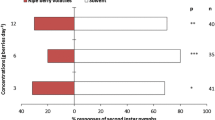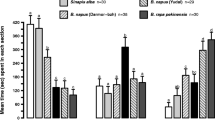Abstract
We evaluated attraction of released mature laboratory-cultured Mediterranean fruit flies to different sources of coffee plant odor placed in potted nonfruiting guava trees in outdoor field cages. Volatiles from crushed medium or dark red fruit ofCoffea arabica cv. arabica plants were significantly more attractive than volatiles from cut leaves or stems of such plants, volatiles from less-ripe crushedC. arabica fruit, and volatiles from crushed red fruit ofC. racemosa,C. canephora, orC. dewevari. Volatiles fromC. arabica cv. arabica crushed red fruit were equally attractive as volatiles from crushed red fruit ofC. congensis orC. arabica cv. mundo, cv. bourbon, cv. kents or cv. catura. Volatiles from as little as 2 g of crushed redC. arabica fruit (= 1 fruit) were as attractive as volatiles from 32 g of such fruit, demonstrating sensitivity of the bioassay approach used to a small amount of source material. Odor ofC. arabica red fruit refrigerated for 1–10 days after picking was significantly more attractive than odor of fresh-picked fruit, while odor of a 24-hr water extract of intact redC. arabica fruit was significantly more attractive than odor of 24-hr extracts of such fruit with methanol, methylene chloride, or hexane or 1- or 6-hr extracts with water. Extraction studies suggested that at least some of the volatiles of red coffee fruit attractive to medflies may be polar water-soluble molecules. In our final test, volatiles from crushed redC. arabica fruit trapped on Super Q and eluted with methylene chloride proved just as attractive as volatiles emanating directly from crushed fruit of the same type. Together, our findings define optimal source material and effective handling procedures of source material for future identification of volatile components of coffee fruit attractive to medflies.
Similar content being viewed by others
REFERENCES
GUTIERREZ-MARTINEZ, A., andONDARZA, R. N. 1996. Kairomone effect of extracts fromCoffea canephora onHypothenemus hampei.Environ. Entomol. 25:96–100.
JANG, E. B., andLIGHT, D. M. 1996. Olfactory semiochemicals of tephritids, pp. 73–90,in B. A. McPheron and G. J. Steck (eds.). Fruit Fly Pests. St. Lucie Press, Delray Beach, Florida.
LIGHT, D. M., andJANG, E. B. 1996. Plant volatiles evoke and modulate tephritid behavior, pp. 123–133,in B. A. McPheron and G. L. Steck (eds.). Fruit Fly Pests. St. Lucie Press, Delray Beach, Florida.
LIQUIDO, N. J.,SHINODA, L. A., andCUNNINGHAM, R. T. 1991. Host plants of the Mediterranean fruit fly: An annotated world review.Misc. Public. Entomol. Soc. Am. 77:1–52.
LYONS, J. M. 1973. Chilling injury in plants.Annu. Rev. Plant Physiol. 24:445–446.
MILLAR, J. 1995. An overview of attractants for the Mediterranean fruit fly, pp. 123–143,in J. G. Morse, R. L. Metcalf, J. R. Carey, and R. V. Dowell (eds.). The Medfly in California: Defining Critical Research. College of Natural and Agricultural Sciences, University of California, Riverside.
NIGG, H. N.,MALLORY, L. L.,SIMPSON, S. E.,CALLAHAM, S. B.,TOTH, J. P.,FRASER, S.,KLIM, M.,NAGY, S.,NATION, J. L., andATTAWAY, J. A. 1994. Caribbean fruit fly,Anastrepha suspensa (Loew), attraction to host fruit and host kairomones.J. Chem. Ecol. 20:727–743.
PAPAJ, D. R.,AVERILL, A. L.,PROKOPY, R. J., andWONG, T. T. Y. 1992. Host marking pheromone and use of previously established oviposition sites by the Mediterrean fruit fly.J. Insect Behav. 5:583–598.
PROKOPY, R. J., andVARGAS, R. I. 1996. Attraction ofCeratitis capitata flies to odor of coffee fruit.J. Chem. Ecol. 22:807–820.
ROBACKER, D. C.,WARFIELD, W. C., andFLATH, R. A. 1992. A four-component attractant for the Mexican fruit fly,Anastrepha ludens, from host fruit.J. Chem. Ecol. 18:1239–1254.
SCARPATI, M. L.,SCALZO, R. L.,VITA, G., andGAMBARCORTA, A. 1996. Chemotropic behavior of female olive fly (Bactrocera olea Gmel.) onOlea europaea L.J. Chem. Ecol. 22:1027–1036.
VARGAS, R. I.,WALSH, W. A., andNISHIDA, T. 1995. Colonization of newly planted coffee fields: Dominance of Mediterranean fruit fly over oriental fruit fly.J. Econ. Entomol. 88:620–627.
Author information
Authors and Affiliations
Rights and permissions
About this article
Cite this article
Prokopy, R.J., Phillips, T.W., Vargas, R.I. et al. Defining Sources of Coffee Plant Odor Attractive toCeratitis Capitata Flies. J Chem Ecol 23, 1577–1587 (1997). https://doi.org/10.1023/B:JOEC.0000006423.53109.15
Issue Date:
DOI: https://doi.org/10.1023/B:JOEC.0000006423.53109.15




